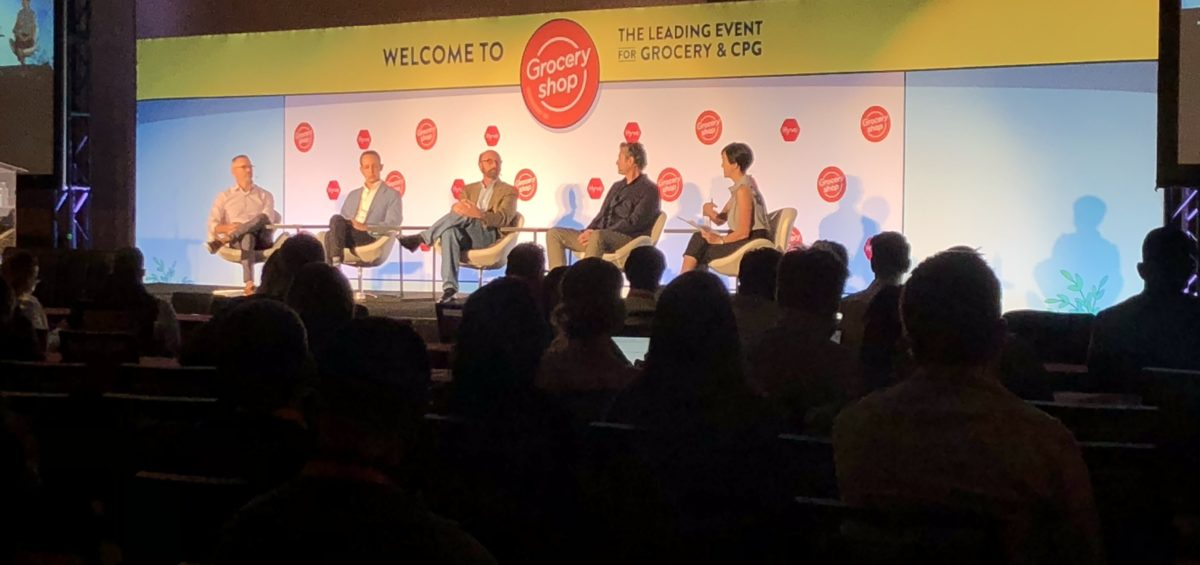We were at Groceryshop in Las Vegas last week and feel grateful to have been able to reconnect with many of our customers and partners in person for the first time in a long time.
Admittedly, it was a bit strange interacting with (or even recognizing) folks when all parties were wearing masks and a bit awkward navigating the uncertainty of how best to greet someone as options ranged from waves to fist bumps to hugs.
What was certain from the event is that the pandemic has created new urgency around solving business challenges, seizing business opportunities, and finding ways to claim unfair advantage in an increasingly crowded marketplace.
According to keynote speaker Mike Del Pozzo, SVP Sales and Chief Customer Officer at Frito-Lay North America, the pandemic has propelled digital growth for his company, enabling them to reach internal goals four years earlier than initially planned.
The headline at Groceryshop 2021 was Gradually, Then Suddenly, Transformation Hits the Grocery Industry “creating a new urgency to embrace innovative technologies and business models.” We found that concept reinforced across the event.
Here are some of the most prevalent transformation themes from Groceryshop 2021 we found compelling:
Demand Forecasting Fix
One major theme across the event was how the pandemic exacerbated demand forecasting challenges for both CPG brands and retailers. Although demand forecasting has historically been driven by a somewhat inaccurate combination of perpetual inventory data and point of sales data, the pandemic put this even more in focus.
A lack of visibility to what was occurring on the store shelf coupled with highly localized, pandemic induced supply shortages resulted in both brands and retailers feeling like they were flying completely blind when it came to demand forecasting.
The business impact of this lack of demand forecasting visibility was amplified by the growth of omnichannel grocery during the pandemic. Mike Molitor, Head of E-Commerce and Loyalty at Bashas’ emphasized the importance of avoiding stockouts in online sales during the New Customer Loyalty Strategies session, since “digitally it is very hard to substitute for the customer”.
Many at the show highlighted how they are looking to solve for more accurate demand forecasting:
Southern Glazer’s Wine and Spirits stated that it’s using a technology to scrape customers’ websites to harvest data on availability to gain a picture of inventory.
GoPuff showcased its vertical integration as a key competitive advantage, enabling control over both delivery and inventory. It currently has 500 micro-fulfillment centers (MFCs) to provide that control.
Google predicted that data will be intelligently used in all areas—from forecasting to personalized experiences.
Independent of the demand forecasting solution, in another related panel Navigating Dynamic CPG-Retailer Relationships, speakers from Anheuser-Busch and Campbell Soup outlined that while retailers and CPG providers are often rivals, mutual benefit can be gained by sharing information, practicing transparency, and building bridges for mutual benefit.
Omnichannel Options
Another major theme that was reinforced throughout Groceryshop 2021 is that the evolution of omnichannel grocery was accelerated dramatically by the pandemic resulting in new market dynamics that both CPG brands and retailers see as a major opportunity for incremental growth.
What started as a pandemic-driven safety offering has matured into a major beachhead for providing more convenience to the shopper, leading to revenue growth and more loyal customers.
According to the panelists in the Deciphering New Customer Behaviors session, grocers are leveraging new technology to improve their ability to pick the right products and serve consumers through convenient fulfillment options and consumers increasingly expect order accuracy and convenience as table stakes for their omnichannel grocery provider.
Chris Rupp, EVP and Chief Customer and Digital Officer at Albertsons noted in her opening remarks that at the onset of the pandemic, Albertsons focused on ensuring every delivery order was correct and on time to ensure the quality of its operations before expanding the program to what now includes a partnership with DoorDash.
The online consumer interface was a major topic at the show with Carrie Tharp, VP, Retail and Consumer for Google Cloud, noting in her keynote that Google believes the future of grocery omnichannel commerce is easy, intuitive, and helpful consumer interactions that will embrace the concept of conversational retail. Chris Rupp from Albertson’s added in an on-stage Q&A related to Albertson’s move to add short form video to its store websites, “This isn’t just about creating new ways to feature our products. This is about bringing delight and inspiration to digital shopping to make online experiences as fun as discovering new products in our stores.”
Another major topic related to omnichannel shopper convenience was the rise of both grocery delivery services, and buy online, pick-up in store (BOPIS) and curbside pick-up alternatives. Speakers from Instacart, DoorDash and GoPuff were all center stage.
In a lively panel discussion entitled Building Better Click-and-Collect, Curbside and Delivery Offerings, the speakers outlined fundamental differences between delivery and pick-up customers including:
- The average order size for delivery is around $50 compared to pick-up orders, which have an average order size of $25.
- Price-conscious consumers are more likely to choose pick-up as delivery fees make delivery the more expensive option.
- Pick-up customers often enter the store to make additional purchases on top of their online order.
- Fulfillment time is a key difference: pick-up typically is significantly faster than delivery.
- Deliveries occur throughout the day—particularly as many people are working from home. Pick-ups generally occur at the beginning or end of the day.
The panelists noted challenges for all omnichannel retailers include data sharing and stockouts caused by supply chain issues and labor shortages.
New Tech Trends
Groceryshop 2021 also providing a showcase for new technology solutions coming onto the scene to help in a variety of business contexts including demand forecasting and omnichannel. In fact, 66% of competitors in the “Shark Reef” Startup Pitch Competition were focused on AI-based technologies to address seamless shopping experiences and supply chain issues.
We spoke on a technology panel entitled Technologies Reinventing the In-Store Experience and sat in on another technology panel called Fulfillment, Pickup and Delivery Technology.
What was clear from the new technology sessions is that digitization and new data signals are proliferating across all aspects of the CPG value chain, from new product innovation to demand forecasting to supply chain management to online experience to in-store fulfillment.
New technologies can be overwhelming, but Peter Strong, Partner at The Partnering Group put it well in his session Succeeding with Grocery E-Commerce Partners and Technologies when he said that when it comes to deployment of new technologies, leaders should envision who they are and where they want to go, visualizing the desired outcome and determining gaps in strategy.
Great conversations at Groceryshop 2021 and beyond
We started a lot of great conversations at Groceryshop 2021 about how Pensa can help with demand forecasting, omnichannel and a host of other critical business issues. If you missed us at the show, please reach out. We may be able to help you with your business priorities.
In addition to our own observations from Groceryshop 2021, we’ve curated some relevant content from our friends at Winsight Grocery Business and CORESIGHT RESEARCH for your benefit.







